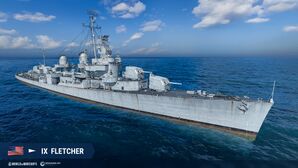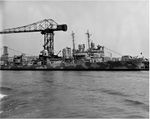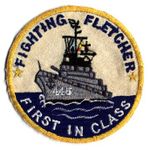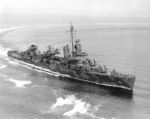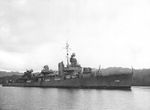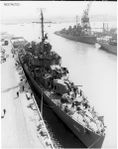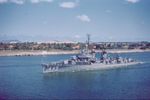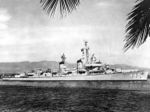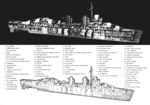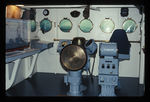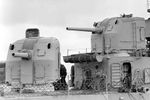Fletcher
| Revision as of 15:00, 21 February 2017 Updated Design History of Fletchers | Revision as of 04:38, 12 July 2017 Added note regarding the maximum range of the 5-inch/38. Removed reference to stealth fire. | |||
| Line 39: | Line 39: | |||
| '''Main Battery (Maximum Rate of Fire) Build:''' Another solid choice for ''Fletcher'' in Upgrade Slot 3 is Main Battery Modification 3. When coupled with Level 3 commander skill Basic Firing Training, her rate of fire increases significantly. In this configuration, the reload time on her main battery guns drops to 2.6 seconds (from a base of 3.3 seconds). | '''Main Battery (Maximum Rate of Fire) Build:''' Another solid choice for ''Fletcher'' in Upgrade Slot 3 is Main Battery Modification 3. When coupled with Level 3 commander skill Basic Firing Training, her rate of fire increases significantly. In this configuration, the reload time on her main battery guns drops to 2.6 seconds (from a base of 3.3 seconds). | |||
| ? | '''Main Battery (Maximum Range) Build:''' Some captains prefer to maximize the range of ''Fletcher''’s main battery guns utilizing Gun Fire Control System Modification 2 in the third upgrade slot. While this pushes her main battery range out to 15 km | + | '''Main Battery (Maximum Range) Build:''' Some captains prefer to maximize the range of ''Fletcher''’s main battery guns utilizing Gun Fire Control System Modification 2 in the third upgrade slot. While this pushes her main battery range out to 15.0 km, landing shells on all but the slowest, largest ships at such range is incredibly difficult. | |
| + | ||||
| + | {{block|!!|content=The historical maximum firing range of the 5-inch/38 caliber guns aboard ''Fletcher'' was approximately 16.0 km. Captains opting for a max range build should equip '''either''' Gun Fire Control System Modification 2 OR take the Advanced Firing Training commander skill. Ordinarily these two would stack to give ''Fletcher''’s guns a range approaching 18.0 km; however, the historical max range of her guns is correctly capped in-game and cannot be pushed past 16.3 km.}} | |||
| |CommanderSkills=<!-- write text about best set of Commander Skills below --> | |CommanderSkills=<!-- write text about best set of Commander Skills below --> | |||
| Line 159: | Line 161: | |||
| ====Design==== | ====Design==== | |||
| ? | As the first class of destroyers produced by a wartime United States, the ''Fletcher | + | As the first class of destroyers produced by a wartime United States, the ''Fletcher''-class was seen as a logical progression from the pre-war designs. The design firm of Gibbs and Cox took their experience in designing the previous ''[[Benson]]'' and ''Gleaves'' classes and sought to rectify the deficiencies in both designs. Coming in above 1,500 tons, the previous designs failed to meet the armament requirement of five (5) 5-inch guns and ten (10) torpedo tubes; they were seen as too small and top heavy. History would prove their third creation to be a war-winner; the mettle and venerability of the ''Fletchers'' were displayed regularly during the grueling combat of the Pacific campaign in World War II. | |
| ? | The ''Fletcher | + | The ''Fletcher''-class ships were the first destroyers in the US Navy to exceed 2,000 tons displacement. In a change from previous design practice, Fletchers had flush decks as opposed to the raised forecastle design seen on the ''Benson class''. This increased her length but decreased her freeboard and improved her handling; overall, this was considered a very structurally sound and seaworthy design. An interesting design choice to note, early built ''Fletchers'' have the taller rounded-tower superstructure design – as seen in game – whereas late build ''Fletchers'' had a superstructure that was lower in height with a flat-faced bridge. | |
| In order to maintain the 38 knot speed despite the increase in tonnage, new propulsion machinery was utilized: boilers that were 20-30% more efficient and turbines that were 20% more powerful than predecessors were installed. Ultimately, a third of the internal space was consumed by propulsion machinery in a unique configuration. The forward boiler and turbine room were separated from the rear boiler and engine room via watertight bulkheads. Each individual segment ran the port and starboard propulsion screws, respectively. This configuration resulted in greater machine survivability from combat damage. | In order to maintain the 38 knot speed despite the increase in tonnage, new propulsion machinery was utilized: boilers that were 20-30% more efficient and turbines that were 20% more powerful than predecessors were installed. Ultimately, a third of the internal space was consumed by propulsion machinery in a unique configuration. The forward boiler and turbine room were separated from the rear boiler and engine room via watertight bulkheads. Each individual segment ran the port and starboard propulsion screws, respectively. This configuration resulted in greater machine survivability from combat damage. | |||
| ? | As required by US Navy specifications, each ''Fletcher | + | As required by US Navy specifications, each ''Fletcher'' class ship was able to mount five (5) 5-inch guns in single, enclosed dual-purpose mounts; two guns forward, two guns rear, and one amidships. All turrets were controlled by Mark 37 and Mark 22 Fire Directors. Feeding information to the gun computer, the main battery could all be remotely controlled if required. Furthermore, the class got to implement SG surface radar and "Variable-Time" proximity fuses — both novelties to the Navy — that allowed effective engagement of both surface and air threats. | |
| ? | Learning from the experience of Pearl Harbor, the Navy decided to invest in heavier anti-aircraft armament. After seeing their effectiveness during the Spanish Civil War, the Navy's Bureau of Ordnance (BuOrd) arranged manufacturing licences for Oerlikon 20mm and Bofors 40mm cannons. Anti-aircraft armament was constantly being changed throughout the war; for instance, the average ''Fletcher | + | Learning from the experience of Pearl Harbor, the Navy decided to invest in heavier anti-aircraft armament. After seeing their effectiveness during the Spanish Civil War, the Navy's Bureau of Ordnance (BuOrd) arranged manufacturing licences for Oerlikon 20mm and Bofors 40mm cannons. Anti-aircraft armament was constantly being changed throughout the war; for instance, the average ''Fletcher''-class destroyer was armed with seven (7) 20mm and ten (10) 40mm AA guns for most of her time in the Pacific. | |
| Finally, the class was able to mount ten (10) torpedoes in two quintuple-tube launchers amidships, the heaviest torpedo broadside of any US Navy destroyer at the time. By also carrying depth charge launchers in conjunction with anti-submarine sonar, ''Fletchers'' were well-equipped to conduct anti-submarine operations as well. Overall, the class was armed with a plethora of tools to combat a myriad of threats. | Finally, the class was able to mount ten (10) torpedoes in two quintuple-tube launchers amidships, the heaviest torpedo broadside of any US Navy destroyer at the time. By also carrying depth charge launchers in conjunction with anti-submarine sonar, ''Fletchers'' were well-equipped to conduct anti-submarine operations as well. Overall, the class was armed with a plethora of tools to combat a myriad of threats. | |||
| ? | In the end, 175 ''Fletchers'' were produced from 11 different shipyards throughout the United States. '' | + | In the end, 175 ''Fletchers'' were produced from 11 different shipyards throughout the United States. USS ''Fletcher'' (DD-445) was the lead ship of her class, built by Federal Shipbuilding and Dry Dock Co. in Kearny, New Jersey. Laid down in 2 October 1941, she was launched 3 May 1942, and commissioned 30 June 1942. | |
| ====Service==== | ====Service==== | |||
Revision as of 04:38, 12 July 2017
| 127 mm/38 Mk.12 on a Mk.30 mod.0 mount5 х 1 pcs. |
| Rate of Fire17.96 shots/min. |
| Reload Time3.34 sec. |
| Rotation Speed34 deg./sec. |
| 180 Degree Turn Time5.29 sec. |
| Firing Range11.77 km. |
| Maximum Dispersion103 m. |
| HE Shell127 mm HE Mk32 |
| Maximum HE Shell Damage1,800 |
| Chance of Fire on Target Caused by HE Shell5 % |
| Initial HE Shell Velocity792 m./s. |
| HE Shell Weight24.5 kg. |
| AP Shell127 mm AP/SC Mk38 |
| Maximum AP Shell Damage2,100 |
| Initial AP Shell Velocity792 m./s. |
| AP Shell Weight25 kg. |
| 533 mm Mk152 х 5 pcs. |
| Rate of Fire0.49 shots/min. |
| Reload Time122 sec. |
| Rotation Speed25 deg./sec. |
| 180 Degree Turn Time7.2 sec. |
| TorpedoMk15 mod. 3 |
| Maximum Damage16,633 |
| Torpedo Speed55 knot |
| Torpedo Range9.15 km. |
| 127 mm/38 Mk.12 on a Mk.30 mod.0 mount5 х 1 pcs. |
| . . . Average Damage per Second53.5 |
| . . . Firing Range5.01 km. |
| 40 mm/56 Bofors on a Mk.1 mount3 х 2 pcs. |
| . . . Average Damage per Second33.9 |
| . . . Firing Range3.51 km. |
| 20 mm Oerlikon on a Mk.4 mount9 х 1 pcs. |
| . . . Average Damage per Second32.4 |
| . . . Firing Range2.01 km. |
| Maximum Speed36.5 knot |
| Turning Circle Radius560 m. |
| Rudder Shift Time4.5 sec. |
| Surface Detectability Range7.16 km. |
| Air Detectability Range3.24 km. |
Fletcher — American Tier IX destroyer.
Fletcher was the lead ship of the most numerous series of destroyers ever produced. They proved to be highly successful ships, combining high speed with efficient AA defenses, quick-firing artillery, and powerful torpedo armament.
Four of the class are preserved as military museum ships: USS Cassin Young in Boston, Massachusetts; USS Kidd in Baton Rouge, Louisiana; USS The Sullivans in Buffalo, New York; and HNS Velos (ex-USS Charrette) in Athens, Greece.
Modules
Compatible Upgrades
| Slot 1 |
|||||
|---|---|---|---|---|---|
| Slot 2 |
|||||
| Slot 3 |
|||||
| Slot 4 |
|||||
| Slot 5 |
|||||
| Slot 6 |
Player Opinion
Performance
Fletcher-class ships were workhorses of the United States Navy during World War II, and their legacy transfers well into World of Warships. Fletcher herself is, without question, the most flexible destroyer in the game. She can be tailored — via Commander Skills and Upgrades — to be a torpedo boat with good guns, or to be a murderous gunboat with above average torpedoes. She is one of a handful of destroyers in the game with decent anti-aircraft armament in her top configuration, and can finally equip the Defensive AA Fire consumable without having to sacrifice any of her five main battery guns.
As with her immediate predecessors, Fletcher’s main battery is punishing to enemy destroyers at close range. The ballistics of her guns make landing shells reliably on targets beyond 7 or 8 km problematic, but in close-quarters combat she has few rivals. Her upgraded torpedoes are the hardest-hitting torpedoes in the American destroyer line, and she retains Benson’s ability to fire them from well beyond her detection range. Her torpedoes also remain more difficult to spot than those of her Japanese or Russian counterparts. Most importantly, Fletcher gains access to Upgrade Slot 3, allowing her captain to tailor her to a torpedo-centric build (via Torpedo Tubes Modification 3 and Torpedo Armament Expertise) or a gun-centric build (with Main Battery Modification 3 and Basic Firing Training) with relative ease.
There are only a handful of categories where Fletcher does not improve upon Benson, and they're relatively minor things (such as air detection radius). Without Defensive AA Fire equipped she's still very vulnerable to enemy planes, and she's noticeably slower than Benson as well. Still, she's a significant upgrade from Tier VIII and a true joy to play... so much so that many players simply stop playing the line at Fletcher and never move on to Gearing.Pros:
- Excellent concealment.
- Punishing main battery reload speed; Fletcher is capable of putting a lot of shells on target in a short amount of time.
- Very fast turret rotation speed.
- Hard hitting torpedoes deal more damage and reload faster than Tier X Gearing.
- Can equip the Defensive AA Fire consumable without giving up any of her main battery guns.
Cons:
- Still fragile; engaging Russian destroyers beyond 6km range is inadvisable, and Fletcher remains vulnerable to cruisers of all tiers she will face.
- As good as her torpedoes are, Yūgumo’s are still faster and pack more punch per hit.
- Slower than Benson.
- Upgraded torpedo range is still 6km shorter than Gearing’s.
- While her anti-aircraft suite is better than most destroyers, it will struggle to shoot down high tier planes.
Research
Optimal Configuration
Fletcher is a highly flexible destroyer capable of being tailored in a variety of different ways. Most captains, however, will choose to focus on improving one of her main armaments to the maximum extent possible.
Upgrades
Most Fletcher captains will equip Main Armaments Modification 1 in Upgrade Slot 1, AA Guns Modification 2 or Aiming Systems Modification 1 in Upgrade Slot 2, Propulsion Modification 1 in Upgrade Slot 4, Propulsion Modification 2 or Steering Gears Modification 2 in Upgrade Slot 5, and Concealment Systems Modification 1 in Upgrade Slot 6. The upgrade chosen for Upgrade Slot 3 — and the corresponding commander skills — is where most of the customization lies.
Torpedo Build: Captains wishing to focus their Fletcher as a torpedo boat will opt for Torpedo Tubes Modification 3 in Upgrade Slot 3. This lowers her torpedo reload to only 90 seconds. If her commander invests in the Level 3 commander skill Torpedo Armament Expertise, the reload time drops to a scant 81 seconds. Given how hard her torpedoes hit and how fast they travel, this configuration of Fletcher can give even the vaunted Japanese destroyers a run for their money in the torpedo damage category.
Main Battery (Maximum Rate of Fire) Build: Another solid choice for Fletcher in Upgrade Slot 3 is Main Battery Modification 3. When coupled with Level 3 commander skill Basic Firing Training, her rate of fire increases significantly. In this configuration, the reload time on her main battery guns drops to 2.6 seconds (from a base of 3.3 seconds).
Main Battery (Maximum Range) Build: Some captains prefer to maximize the range of Fletcher’s main battery guns utilizing Gun Fire Control System Modification 2 in the third upgrade slot. While this pushes her main battery range out to 15.0 km, landing shells on all but the slowest, largest ships at such range is incredibly difficult.
The historical maximum firing range of the 5-inch/38 caliber guns aboard Fletcher was approximately 16.0 km. Captains opting for a max range build should equip either Gun Fire Control System Modification 2 OR take the Advanced Firing Training commander skill. Ordinarily these two would stack to give Fletcher’s guns a range approaching 18.0 km; however, the historical max range of her guns is correctly capped in-game and cannot be pushed past 16.3 km.
Commander Skills
Regardless of other choices, Fletcher commanders should always invest in Preventative Maintenance at Level 1, Last Stand at Level 2, Survivability Expert at Level 3, and Concealment Expert at Level 4. Where points go after that depends on how captains wish to play the ship.
A Torpedo Build Fletcher will want to invest in Torpedo Armament Expertise at Level 3, whereas a Main Battery Build Fletcher will want to pick up Basic Firing Training — and probably Demolition Expert — instead. Captains concerned about enemy aircraft could opt for Advanced Firing Training or Manual Fire Control for AA Armament. The latter is the better option, as Fletcher will run most of the time with her anti-aircraft guns disabled in order to avoid detection (making the additional AA range less valuable).
| Recommended Commander Skills | ||||||||
|---|---|---|---|---|---|---|---|---|
| Cost (points) |
Endurance | Attack | Support | Versatility | ||||
| 1 |
★ |
★★★ |
|
|
|
|
|
|
| 2 |
★★ |
★ |
|
|
★ |
|
★★ |
★★★ |
| 3 |
|
★★★ |
★★ |
|
★★ |
★★ |
★★ |
★★ |
| 4 |
|
|
★ |
|
★ |
|
|
★★★ |
| Key: ★★★ - Extremely Useful ★★ - Frequently Useful ★ - Occasionally Useful No stars - Meh Χ - Not recommended | ||||||||
Consumables
Even if her captain doesn't sink any commander skill points or upgrades into improving her anti-aircraft suite, Defensive AA Fire is recommended over Engine Boost due to the extreme threat that enemy aircraft create for a Fletcher. Simply having it equipped and demonstrating to an enemy carrier that it is available is frequently a deterrent to them swarming Fletcher with bombers or assigning a fighter squadron to keep her spotted.
Beyond that, Damage Control Party II is worth the credits (or doubloons) for the shortened cooldown on repairing broken modules.
Camouflage
Type 1, 2, or 5 camouflage can be equipped for credits; Types 1 or 5 are recommended at a minimum to reduce detectibility range.
Players who wish to spend doubloons can equip Fletcher with Type 19 camouflage that lowers her detection radius, reduces the accuracy of incoming shells, reduces her repair costs, and increases the amount of experience she earns.
Signals
Captains who have opted for a Torpedo Build Fletcher will want to equip a Juliet Whiskey Unaone signal in order to maximize potential damage from torpedo hits. Throwing on a Sierra Mike signal is an excellent way to help make up for her loss of speed from Benson. November Foxtrot and Juliet Charlie are also highly recommended, if available. Main Battery Build Fletcher captains should also consider Victor Lima and India X-Ray signals to increase the fire chance of her main battery shells.
Recommended Signal Flags 
| |||||
|---|---|---|---|---|---|
| Combat | |||||
 ★★★ |

|

|
 ★ |
 ★★ |
 ★★ |
 ★★ |

|
 ★ |
 ★★★ |
 ★★★ |

|

|

| ||||
Note: Use of the Juliet Charlie signal makes detonation impossible.
Gallery
Historical Info
Historical Gallery
